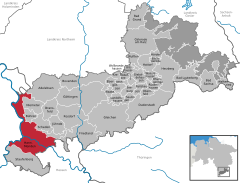Hann. Münden
You can help expand this article with text translated from the corresponding article in German. (March 2013) Click [show] for important translation instructions.
|
Hann. Münden | |
|---|---|
 Town hall | |
Location of Hann. Münden within Göttingen district  | |
| Country | Germany |
| State | Lower Saxony |
| District | Göttingen |
| Subdivisions | 11 |
| Government | |
| • Mayor | Harald Wegener (Bürgerforum Hann. Münden) |
| Area | |
| • Total | 121.12 km2 (46.76 sq mi) |
| Elevation | 123 m (404 ft) |
| Population (2013-12-31) | |
| • Total | 23,668 |
| • Density | 200/km2 (510/sq mi) |
| Time zone | UTC+01:00 (CET) |
| • Summer (DST) | UTC+02:00 (CEST) |
| Postal codes | 34346 |
| Dialling codes | 05541 |
| Vehicle registration | GÖ, DUD, HMÜ |
| Website | www.hann.muenden.de |
Hann. Münden (short for Hannoversch Münden, colloquially called Münden) is the German official name of a town in Lower Saxony, Germany. The city is located in the district of Göttingen at the confluence of the Fulda and Werra rivers, which join to form the river Weser. It has about 24,000 inhabitants (2013). It is famous for its several historical houses, some of them more than 600 years old.
Name
The name of the town was originally Münden. For postal purposes it was often confused with Minden which also lies along the Weser river, and sometimes with Munich (German: München). The official name was changed to Hannoversch Münden (during its 19th-century affiliation with the Kingdom of Hanover) in order to distinguish the city from then Prussian-affiliated Minden (which is similarly pronounced). To avoid confusion with Hannover-Schmünden, Hannover-Münden, Hannover bei Münden and Hannover bei München, the city's name was abbreviated by the Hanoverian Southern Railway to Hann. Münden on passenger tickets following the 8 May 1856 opening of the line, which became its official name in 1991. Inhabitants still generally refer to their own town as Münden.
History


The place is first mentioned in the deeds of donation of Gimundi to the abbey of Fulda, in 802.
City rights might have been granted during the latter half of the 12th century.[1]
The French inventor Denis Papin built a steam-pump-powered paddlewheel boat, probably pedal-driven in 1704, and as a demonstration used it to navigate down the Fulda River from Kassel to Münden in 1707.[2]
Hann. Münden was the site of the Royal Prussian Academy of Forestry: the city's botanical gardens with many different trees were primarily established for this academy. Later the academy was merged into the University of Göttingen, moving to a new building on the main campus in 1970.[3]
Main sights
Many tourists visit the city to see its some 700 well-preserved half-timbered medieval houses.
The large Lutheran church of St Blasius (14th-15th centuries), in Gothic style, contains the sarcophagus of Duke Eric I of Brunswick-Calenberg (d. 1540).[1]
Other sights include:
- Renaissance Town Hall, built in the 14th century (now the central Gothic hall remains) with a façade renewed between 1603 and 1618.
- Old Werrabrücke, the bridge over the Werra river: one of the oldest stone bridges in the country
- Forstbotanischer Garten in Hannoversch Münden, an arboretum
- Remains of the medieval 12th century city walls (renewed in the 15th century)[1]
- Tillyschanze, an observation tower built from 1881 to 1885 by citizens of the town[citation needed] in memory of the siege of the town by Count Tilly in 1626.[1]
- Welfenschloss, originally built by Duke Eric I in the Gothic style in 1501, as both a residence and administrative center. After its destruction by a fire in 1560, Duke Eric II had it rebuilt in Weser Renaissance style. The southern wing was again destroyed by a fire in 1849, but not rebuilt.
Notable people born in Hann. Münden
- Anna Marie of Brunswick-Lüneburg (1532–1568), duchess of Braunschweig-Lüneburg.
- Ludolph Büsinck (1600–1669), wood-engraver.
- Eduard Huschke (1801–1886), jurist.
- Christian Kalkbrenner (1755–1806), kapellmeister.
- Anne-Marie von Schutzbar genannt Milchling (1903–1991) second wife of Nikolaus, Hereditary Grand Duke of Oldenburg.
- Christa Schroeder (1908–1984), personal secretary to Adolf Hitler.
- Hermann Friedrich Teichmeyer (1685–1746), forensics physician.
- Ferdinand Wüstenfeld (1808–1899), literary historian of Arabic literature.
Twin towns
 Suresnes, France, since 1959
Suresnes, France, since 1959 Hackney, United Kingdom, since 1973
Hackney, United Kingdom, since 1973 Holon, Israel, since 1988
Holon, Israel, since 1988 Chełmno, Poland, since 1992
Chełmno, Poland, since 1992
See also
References
- ^ a b c d Chisholm 1911, p. 4.
- ^ Steamboat Accessed: May 27, 2013]
- ^ Faculty of Forest Sciences and Forest Ecology, "Introduction" Accessed: May 6, 2012]
- Attribution
- This article incorporates text from a publication now in the public domain: Chisholm, Hugh, ed. (1911). "Münden". Encyclopædia Britannica. Vol. 19 (11th ed.). Cambridge University Press. p. 4.
External links
- http://www.hann.muenden.de/ - Official city homepage
- http://www.hann.muenden-tourismus.de/ - Official tourist office of Hann. Münden


